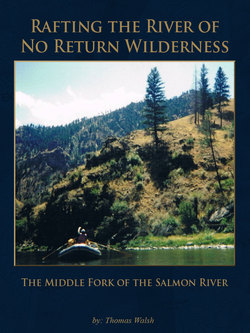Читать книгу Rafting the River of No Return Wilderness - The Middle Fork of the Salmon River - Thomas Walsh - Страница 7
Chapter 5 The River
ОглавлениеThe Middle Fork of the Salmon River is a section of the Main Salmon River. The Main Salmon River is a tributary of the Snake River, which in turn is the largest tributary of the Columbia River. The Columbia River flows into the Pacific Ocean. Water from snowmelt or rain coming from the confluence of the Bear Valley Creek and the Marsh Creek form the Middle Fork about 20 miles northwest of Stanley, Idaho. It works its way down from an altitude of 7,000 feet to eventually flow into the waters of the Pacific Ocean, a journey of more than 1,000 miles.
On its journey, the Middle Fork winds its way 106 miles through one of the deepest gorges in North America with peaks as high as 10,000 feet. Approximately 100 tributaries add to the flow of the Middle Fork. It drops through 300 rateable rapids to an altitude of 3,900 feet by the time it joins the Main Salmon. Rapids on the Middle Fork range from Class I-VI and include strange and alluring names – Velvet Falls, Power House, Pistol Creek, Tappan Falls, Porcupine, Redside, and Rubber, to name a few.
The Class of rapids is rated based on the European Rapid Rating System. The ratings indicate the difficulty of each rapid at a medium water level.
| Class I | Very Easy – small regular waves and riffles; few or no obstacles; little maneuvering required. |
| Class II | Easy – small waves with some eddies, low ledges, and slow rock gardens; some maneuvering required. |
| Class III | Medium – numerous waves that are high and irregular; strong eddies; narrow, but clear passages that require expertise in maneuvering; scouting from shore necessary. |
| Class IV | Difficult – long rapids with powerful, irregular waves, dangerous rocks, and boiling eddies; precise maneuvering and scouting from shore imperative; take all possible safety precautions. |
| Class V | Very Difficult – long rapids with wild turbulence and extremely congested routes that require complex maneuvering; a danger to your life and boat and near the limits of navigation. |
| Class VI | The Limits of Navigation – rarely run; a definite hazard to your life. |
In early spring the volume of water flowing down the Middle Fork can be up to 15,000 cubic feet per second making the river navigable for rafts from Boundary Creek Camp, Mile 0.0. This huge flow creates a wild, swift ride down the river that is best left to experienced river runners. By midsummer, most of the snow has melted. Water volumes can drop below 5,000 cubic feet per second making the ride down the Middle Fork slower, but technically more challenging as rafts and kayaks must navigate through more boulders in the rapids. The Middle Fork is a “Technical” white-water river; meaning that the main challenge is maneuvering around obstacles as the river rushes through rapids. Rivers like the Colorado and Snake are big “Volume” white-water rivers. The main challenge on this type of river is to navigate through rapids with huge waves created by the large volume of water flooding over submerged rocks and boulders.
Artifacts found in rock shelters along canyon walls confirm that primitive man lived beside the Middle Fork over 8,000 years ago. Shoshone Indians were living in the Salmon River area when white men arrived. The Middle Fork was first visited by white men in 1824 when a party of Hudson Bay Company trappers and Iroquois trappers visited the area in search of beaver. In 1863 John Stanley the namesake of Stanley, Idaho, led a party to the area in search of gold. The Sheepeater Campaign of 1879 saw a band of Northern Shoshone Indians known as Sheepeater Indians, due to their dependence on mountain sheep for food, pursued by the U.S. Army in the Middle Fork wilderness. The Indians, 51 in total, eventually surrendered after being worn down by their pursuers.
As early as 1905 the need to protect the Middle Fork wilderness for posterity began to take shape with designation by President Theodore Roosevelt of the area as the Sawtooth Forest Reserve. In 1968, the Middle Fork was one of the original eight rivers in the U.S. designated as Wild and Scenic. The Middle Fork of the Salmon and the Main Salmon River are among the few major western rivers without dams. Guaranteeing the protection of this national treasure, the President of the United States in 1980 established the Frank Church – River of No Return Wilderness, which includes the Middle Fork in its entirety.
The Middle Fork area is 2,500 square miles of rugged and unforgiving landscape. In addition to the wild and challenging river it has six hot springs and numerous points of interest including abandoned homesteads, prospector digs, caves, American Indian pictographs and historical sites. An abundance of wildlife includes salmon, trout, whitefish, big horn sheep, mule deer, mountain goats, elk, bobcat, mountain lion, black bear and moose. About one-third of Chinook Salmon spawning nests occur in the Middle Fork and its tributaries. Human development is limited to a few trails, landing strips, private ranches and Forest Service stations. Unlike Yellowstone or Yosemite, it is unusual to see anyone outside of your own party, unless you happen to pass or be passed by another group, or stop at one of the private ranches.
We were incredibly fortunate to have the opportunity to experience the beauty and challenge of this Wild and Scenic River.
